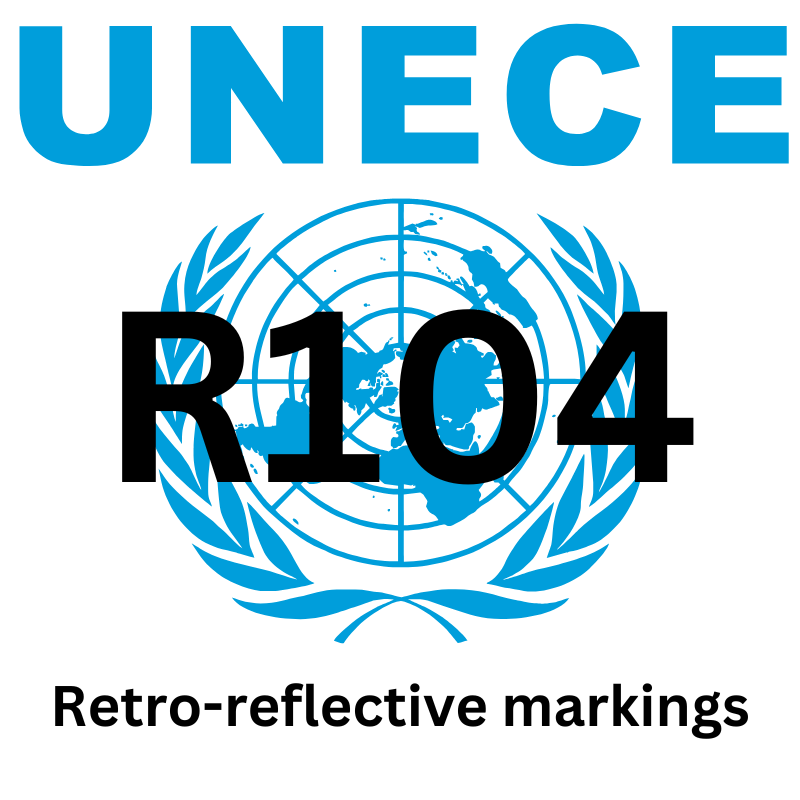Guide To: UNECE R104 - Retro-reflective markings
05 July 2018

Guide To: UNECE R104 - Retro-reflective markings
UNECE Regulation No. 104 focuses on the retro-reflective markings used on heavy and long vehicles, particularly those in categories M, N, and O. These markings are designed to increase vehicle visibility, enhancing road safety by making these larger vehicles more noticeable, especially at night or in low-light conditions. This regulation sets out the technical requirements for these reflective markings, ensuring they meet specific performance standards for durability, colour, and reflectivity.
Key Provisions of UNECE Regulation No. 104
The regulation primarily covers retro-reflective markings, which are applied to vehicles to improve their visibility from the side and rear. These markings are typically found on heavy goods vehicles, long vehicles, and their trailers. The regulation outlines several critical requirements:
Material and Colour Specifications:
The markings must be made from durable, retro-reflective materials, which are either white, yellow, or red. These colours are chosen for their high visibility in various lighting conditions. Retro-reflective materials are specifically engineered to reflect light from other vehicles’ headlights, ensuring that the vehicle remains visible from a distance.
Size and Shape:
The markings are generally applied as strips along the sides and rear of the vehicle. The minimum width for these strips is specified at 50 mm, with the length of the marking determined by the vehicle’s dimensions and the type of marking being applied.
Photometric Requirements:
The regulation sets photometric performance standards, requiring the markings to reflect a specific amount of light. This ensures that the vehicle is visible from sufficient distances, which is critical for avoiding accidents, especially on highways or in poor visibility conditions.
Durability and Resistance:
The markings must pass several tests to ensure they can withstand environmental challenges. This includes resistance to weathering, fuel, heat, and cleaning agents. They are also subjected to tests for flexibility, ensuring they remain effective when applied to curved or flexible surfaces such as tarpaulins on trailers.
Installation and Marking Requirements:
The regulation prescribes guidelines for the placement and installation of the markings. They must be applied in a way that maximizes their visibility from all relevant angles, ensuring other road users can easily spot the vehicle. Additionally, each marking must bear the approval mark, which indicates compliance with UNECE standards.
As part of UNECE's efforts to streamline and simplify vehicle safety regulations, UNECE Regulation No. 104 has been incorporated into the broader UNECE Regulation No. 150. This new regulation consolidates several older regulations, including Nos. 3, 27, 69, 70, and 104, into a single cohesive document covering retro-reflective devices and markings for vehicles.
By consolidating these regulations, UNECE aims to reduce the complexity of compliance for manufacturers and improve regulatory efficiency for approval bodies. Regulation No. 150 now governs all aspects of retro-reflective devices and markings, ensuring that the standards set forth in Regulation No. 104 for heavy and long vehicles are upheld, while also making it easier for manufacturers to meet these requirements across various types of vehicles.
Conclusion
UNECE Regulation No. 104 plays a critical role in ensuring the visibility of heavy and long vehicles on the road. By setting rigorous standards for retro-reflective markings, the regulation helps to prevent accidents, particularly in low-light or poor visibility conditions. With its incorporation into Regulation No. 150, these important safety provisions continue to be enforced, ensuring that vehicle manufacturers and operators comply with international safety standards while benefiting from a more streamlined regulatory framework. For businesses involved in the manufacture or application of retro-reflective materials, compliance with these regulations is essential to maintaining high safety standards and enhancing road safety globally.
Guides to ECE Regulations,E-Mark,ECE Regulation 104,RLVR,Road Vehicle Lighting Regulations,Conspicuity Tape,Contour Tape,Tanker Tape,